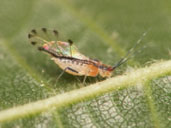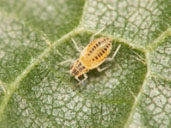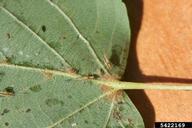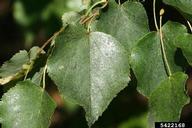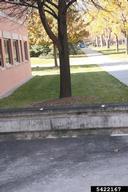Linden aphid
Eucallipterus tiliae (L.) (Hemiptera Aphididae)
Orientation to pest
Linden aphid, Eucallipterus tiliae (L.), is invasive in the United States. It is native to the Eurasia, but now occurs worldwide, wherever species of native or introduced linden trees (Tilia) occur. The winged adults are easily recognized by the black stripe along the body and the cloudy-black at the wing edge. Trees planted along streets and by parking areas are frequently attacked, and the honeydew produced by the aphid makes walkways and cars parked beneath them sticky. Sooty mold growing on honeydew blackens the leaves. Progeny are produced continuously during the growing season. It is attacked by several genera of parasitoids as well as lady beetles and other generalist predators.
Hosts commonly attacked
Basswood, also called American linden, (Tilia americana L.) and its variety, white basswood (T. americana var. heterophylla) are North American trees that are fed on by this aphid. However, damage to these plants is rarely serious because they are less susceptible to this aphid than are the introduced species of Tilia commonly planted in urban landscapes. Damage to such introduced species is the main focus of concern with this aphid.
Distribution
This aphid is found widely in eastern North America on basswood and on exotic species of Tilia in landscape plantings. California, especially, has problems with this aphid on exotic Tilia and has introduced parasitoids for its biological control.
Images of linden aphid
| Figure 1. Winged adult linden aphid | Figure 2. Nymph of linden aphid | Figure 3. Group of winged adult linden aphids on underside of Tilia leaf |
| Figure 4. Honeydew and sooty mold on linden, typical signs of linden aphid | Figure 5. Dark discoloration on cement caused by sooty mold growing on honeydew dripping from linden tree infested by linden aphid |
Important biological control agents related to this pest species
In California, where this is an invasive aphid on exotic street trees, a species of European parasitoid, Trioxys curvicaudus Mackauer, was introduced and anecdotal information suggests this introduction lowered density of aphids on street lindens. In Europe, parasitoids seem not to be the primary regulator of linden aphid numbers, and generalist predators and density-dependent feedback from the tree are believed to be important. This aphid and seven related species occur in northern China and the Russian Far East; hence, this area may be a good source of natural enemies. There are ten parasitoid species in the superfamily Ichneumonoidea and nine in the Chalcidoidea recorded from aphids in the genus Eucallipterus.
Articles
- Dixon, A. F. G. and N. D. Barlow. 1979. Population regulation in the lime aphid. Zoological Journal of the Linnean Society 67: 255-237.
- Zuparko, R. 1983. Biological control of Eucallipterus tiliae [Hom.: Aphididae] in San Jose, California, through establishment of Trioxys curvicaudus [Hym.: Aphidiidae]. Entomophaga 28: 325-330.
- Hajek, A. E. 1986. New North American records of European parasitoids (Hymenoptera) of the linden aphid, Eucallipterus tiliae (Aphidoidea: Drepanosiphidae). Journal of the New York Entomological Society 94: 443-446.
- Blackman, R. L. and V. F. Eastop. 1994. Aphids on the World's Trees: An Identification and Information Guide. CAB International, Oxfordshire, United Kingdom.
- Zuparko, R. L. and D. L. Dahlsten. 1996. New potential for classical biological control of Eucallipterus tiliae (Homoptera: Drepanosiphidae. Biological Control 6: 407-408.
- Foottit, R. G., S. E. Halbert, G. L. Miller, E. Maw, and L. M. Russell. 2006. Adventive aphids (Hemiptera: Aphididae) of America North of Mexico. Proceedings of the Entomological Society of Washington 108(3): 583-610.
